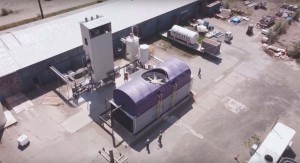A popular bible tale tells how water was turned into wine for thirsty wedding guests. And alchemists once hoped to turn lead and other base metals into gold. Now, a team of Harvard scientists say they’ve found a way to do something equally miraculous: transforming CO2 from the air we breathe into gasoline.
A new paper published this week in the scientific journal Joule says the Harvard University researchers, working with the Canadian energy company Carbon Engineering, have found a way to remove a metric ton of CO2 from the atmosphere for no more than $232, and possibly as little as $94. By using a little magic – and some limestone and hydrogen — that an alchemist would be proud of, the process can then yield new hydrocarbon fuels, such as gasoline or jet fuel.
The basic concept, known as “direct air capture,” or DAC, has been around for some time. The problem has been finding a way to drop costs and then make it work on a large scale.
“Until now, research suggested it would cost $600 per ton…making it too expensive to be a feasible solution to removing legacy carbon at scale,” said Harvard Prof. David Keith in a statement. “We now have the data and engineering to prove that DAC can achieve costs below $100 per ton.”
(EPA moves forward on plan to roll back mileage rules. Click Here for the latest.)
Keith is founder of British Columbia-based Carbon Engineering, a firm that has received critical start-up funding from Bill Gates. It is already operating a pilot plant in Squamish, less than an hour’s drive from Vancouver.

The pilot plant handles just 1 metric ton of CO2 a day - to make 2 bbls of fuel - but could be scaled up.
The facility uses “contactors,” sort of the opposite of a smokestack, to suck in air and expose it to an alkaline liquid that CO2 naturally wants to combine with. The liquid goes through a series of steps that include freezing it into pellets and then transforming it into a slurry. Eventually, it is combined with hydrogen gas – the other major ingredient in hydrocarbons like petroleum. The result is a compound that can be converted whatever liquid fuel is chosen using the same Fischer-Tropsch processes as a conventional refinery.
If Keith’s company can live up to promises laid out in the new Harvard study it would leapfrog Climeworks, a Swiss company that has already launched a commercial-scale plant that can use its own DAC process for around $600 a metric ton. At least six other companies are also working on their own versions of the process.
The Carbon Engineering facility is far smaller than the Climeworks operations, currently removing just one metric ton, or 2,200 pounds, of CO2 from the atmosphere each day. That’s enough to produce two barrels of fuel, however. And a spokesman for the firm said it can readily scale up using off-the-rack hardware, The downside is that the plant is currently using some natural gas for power, but the goal is to switch to renewable electricity.

The plant draws in air, CO2 being scrubbed out and eventually combined with hydrogen to form a variety of different liquid fuels.
The firm estimates it would be able to produce gasoline for about 25% more than using natural petroleum, but is looking for ways to bring the price down. And with oil prices surging in recent months, it might not have to worry about being able to compete with traditional sources.
That doesn’t even factor in the costs associated with global warming, a problem directly associated with rising levels of CO2 in the atmosphere. If that problem is not addressed, experts stress, the price tag could run into the trillions of dollars in terms of flooding, as oceans rise and the weather grows more volatile, losses in food production and other problems. With the exception of the U.S., which pulled out of the Paris Accord on climate change, most nations plan hefty spending of their own to reduce the production of CO2 and other global warming gasses.
(Freightliner launching two battery-powered semi trucks. Click Here for more.)
The new study indicates there are other ways that the Canadian company’s technology can deal with excess CO2. It could be paired with a process in which emissions from a factory or power plant are sequestered, or stored underground, rather than being released into the atmosphere. In turn, that CO2 could be treated and transformed into liquid fuel.
In an interview with The Atlantic, Keith said he is now looking for additional funding to set up an industrial grade plant that could be up and running by 2021.
(Hamburg becomes 1st city to ban older diesels. Click Here for the full story.)


Sounds a bit like the biofuel fiasco; more fuel was used in production than was made.
They need to run the plant on the ‘fuel’ it produces. Whatever is left over is what it can sell.
Don’t hold your breath.